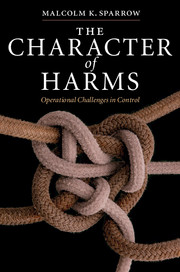Book contents
- Frontmatter
- Contents
- List of figures
- Acknowledgments
- Introduction
- Part I The nature of the control task
- 1 Which way up, and does it matter?
- 2 A different type of work
- 3 Defining problems: setting the scale
- 4 Defining problems: picking the dimensions
- 5 Patterns of thought and action
- 6 Puzzles of measurement
- 7 Structures, protocols, and interactions
- Part II Special categories of harms
- Conclusion
- Index
2 - A different type of work
from Part I - The nature of the control task
Published online by Cambridge University Press: 06 July 2010
- Frontmatter
- Contents
- List of figures
- Acknowledgments
- Introduction
- Part I The nature of the control task
- 1 Which way up, and does it matter?
- 2 A different type of work
- 3 Defining problems: setting the scale
- 4 Defining problems: picking the dimensions
- 5 Patterns of thought and action
- 6 Puzzles of measurement
- 7 Structures, protocols, and interactions
- Part II Special categories of harms
- Conclusion
- Index
Summary
To do any type of work well, surely one would first have to recognize that type of work (perhaps distinguishing it from other types of work), then figure out how to organize it, how to perform it, and finally how to explain to your audience what you did. The acronym ROPE (recognize, organize, perform, explain) acts as a crude but useful starting point in diagnosing just how far any agency or institution has come in mastering the art of harm reduction. A few organizations do just fine all the way up to the end, but are stuck on “explain”: they do terrific work but have not figured out how to tell the risk-control or harm-reduction performance story in a convincing manner. Others have not come so far, and — even though they recognize the form of work — have little idea how to organize it and conduct it on an ongoing basis. I find that these are the agencies that tend to ask for help, or send their executives on courses; they sense the significant opportunities that might result from mastering this art, even while they lack any formal systems to support it. These agencies, by the way, tend to be the pioneers, at least by comparison with the rest of the field. It seems many agencies and institutions have not even made it to the recognition stage yet. I certainly hope this book will help them get at least that far.
- Type
- Chapter
- Information
- The Character of HarmsOperational Challenges in Control, pp. 47 - 72Publisher: Cambridge University PressPrint publication year: 2008



